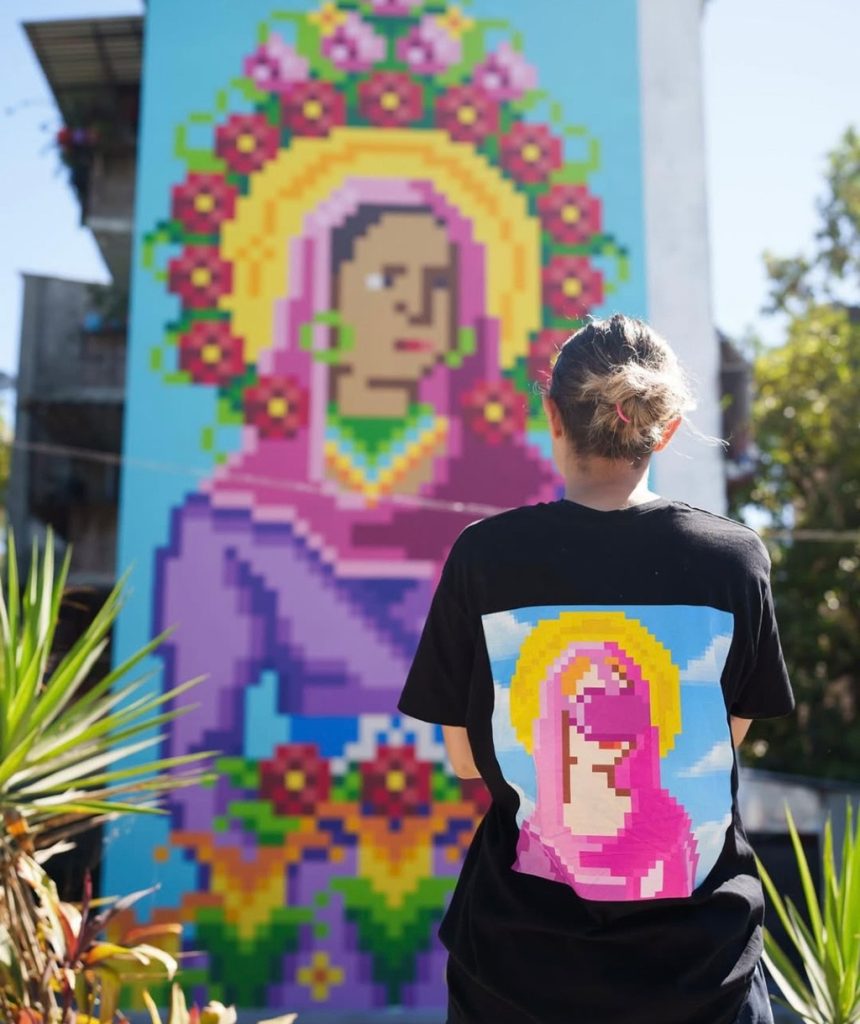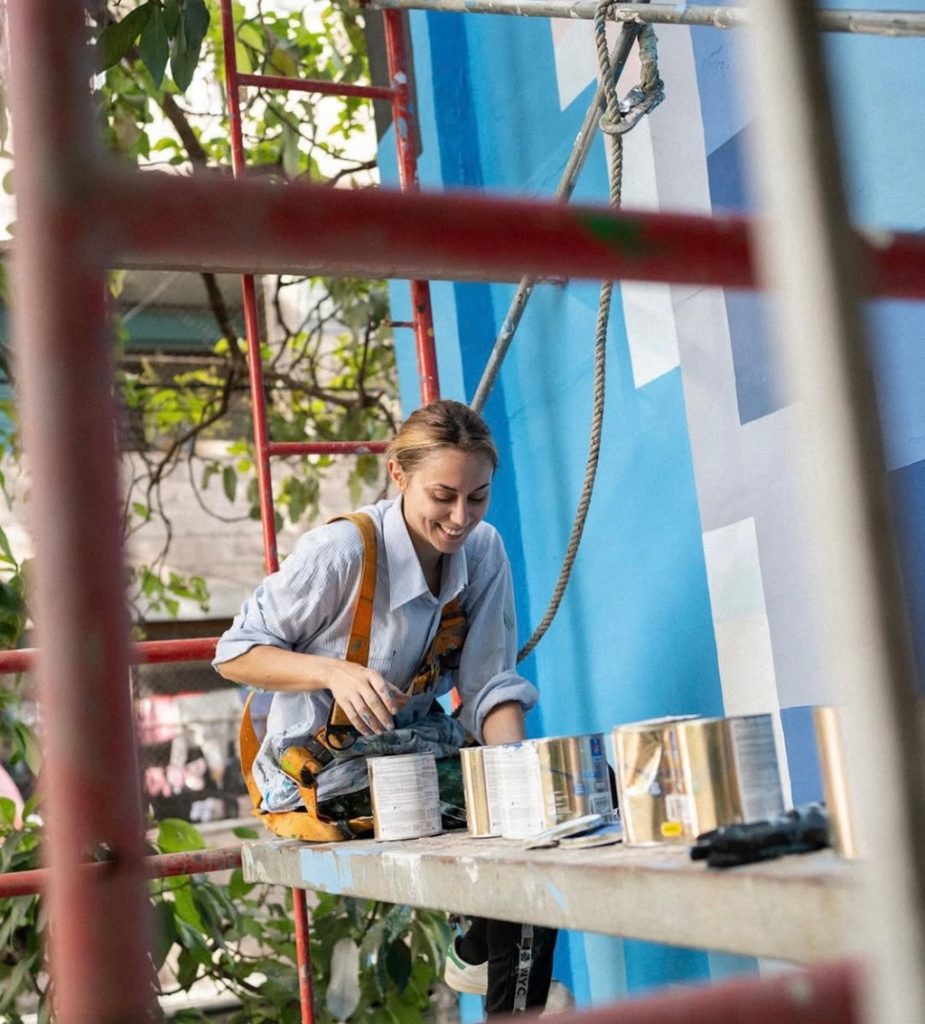Emma Cieslik writes about Beatrice Vigoni’s pixelated homage to the Salvadorian icon, La Señora de la Paz.
This past year, Beatrice Vigoni painted a mural of the Mother of God in El Salvador. One of the founding members of the Holy Club—a creative studio founded by seven creatives—Vigoni said the transition to murals was natural. Her mural was a pixelated reinterpretation of the traditional Salvadoran icon La Señora de la Paz, a reference to how her art explores the spiritual and symbolic ancestry of the Virgin Mary and its impact on women in Christian nations today.
Vigoni began the project after meeting Valentina Picozzi, Glen Lasio, and Giangiacomo Cirla, founder of the urban regeneration project Custom Made Stories in the Zacamil neighborhood of El Salvador. After seeing Vigoni’s work at an event in Lugano, the trio invited Vigoni and the Holy Club team to join the project–this was the first mural of the project and one that decorated a wall with bullet holes, lingering scars from the Salvadoran civil war and resulting gang conflict.
The journey of creating this street art took Vigoni halfway around the world. Born in Italy to artist parents, she was raised with a deep curiosity for how the shapes and symbols around her informed how she constructed her world and made meaning. The Greek principle of Kalokagathia, or the idea that creating and stewarding aesthetics is a form of service to the community, influenced her training ever since she was 14.
Although raised in a religiously independent family, she grew up surrounded by Catholic symbolism in Italy and first began her formal artistic training at an art high school run by the Congregation of the Sisters of the Precious Blood. Her grandmother taught her to pray through which dynamic inner visions form in her mind; her mother taught her that each person’s relationship with the divine changes over time; and her geometry drawing teacher, Sister Teresa, played a key role in her personal journey.
Art, she says, “has a spiritual nature, as it touches the depths of the human psyche, speaks from within it, and finds expression through the primary forms of nature.” This is the central ethic of the Holy Club, founded shortly after Domenico–her husband and fellow artist–came up with the idea for the CryptoMaDonne Holy Club project in 2021. While CryptoMaDonne was a project that originally started as a collective NFT, Holy Club evolved into an artistic collective with the sacred value of promoting beauty and awareness through art, philosophy, and technology.
Currently, Holy Club is based in a renovated warehouse in Carnate, Italy. This warehouse houses their large-scale installations, and as of December 8, 2022, is the headquarters for the CryptoMaDonne Holy Club project that has spread from Italy to El Salvador and beyond.
But at the center of this work is Vigoni’s own fascination with the Mother of God as a symbol. Ever since she was young, Mary has been a loving maternal figure for Vigoni. Like many women grappling with their existence in a country and church that emphasises patriarchal hierarchy control, “Mary was the spiritual reference,” Vigoni said, “that allowed me to connect with my feminine essence.” Yet, exploring Mary as a symbol for divine motherhood often led to more questions.
“If Mary is the greatest female reference and is venerated as a symbol of femininity, why do so many forms of gender violence and inequality still persist? Why,” she continued, “despite the respect given to Mary and the deep bond every man has with his mother, does a view that reduces women to objects of possession and control still prevail?”
Mary is a key, perhaps the strongest, symbol of what a mother is within Christian cultures and countries, yet her presentation of motherhood is one closely tied to sexual purity. “She is the ultimate female figure, the redeemer of Eve, but this narrative is incomplete, especially because we have very little concrete information about her,” Vigoni explained, and as a result, her story–her symbolism as the ultimate, divine-bearing mother is often leveraged to reinforce patriarchal ideas surrounding devotion, submission, and sexual purity.
As a result, Vigoni experienced what many other women and mothers do–feelings of inadequacy for not being able to measure up to this ideal–a miracle that consecrated the Mother of God by maintaining her purity while also allowing her to bear a child. In countries around the world, including Italy and the United States, where pronatalism–the philosophy rewarding and glorifying women and families for having more children–is thriving as birth rates decline, Vigoni witnessed firsthand how this singular, often sexist interpretation of Mary hurt women.
Thus, the mission of CryptoMaDonne–a project dedicated to women and human rights through art–began. Between October and November 2021, Domenico came up with the idea of creating an NFT collection. The digital artistic medium is controversial among creative communities, especially when created with AI-image generating programs and NFT values are deeply unstable, so Vigoni set out to create a fresh and marked a new, multi-dimensional interpretation of Mary, or a human mother, and sell them to raise money for women and human rights.
Since then, she has reimagined Mary in a number of different ways, from decked out in rainbow, smoking, or chewing bubble gum, her hair, eye, and skin color as different as Mary’s devotees.
The name of the project itself is symbolic. “Crypto” denotes the idea of something hidden or concealed, whereas Madonna means “my woman” and is a title of devotion and respect. So, in essence, the project name “Crypto Ma Donne” truly translates to “Crypto But Women.” Along with disrupting Christian patristics, the project also disrupts the association of crypto art and further crypto culture with the wider Manoverse, a conglomerate of influencers, podcasters, and far-right leaders that seek a return to a strict interpretation of gender roles.
These movements overlap with men’s rights campaigns, incel culture, and “red pill” philosophies that are increasingly aligning themselves with far-right Christian religions to leverage conservative interpretations of Mary for their own objectives. No woman could ever live up to the model of Mary–the pressure to do so deeply affected Vigoni, yet men use this same symbol to argue that the ideal woman is submissive, devoted, obedient, a contradiction–a virgin Mother–reinforced by social and political norms that strip her of her rights.
Thus, the project centered around creating a new, more complex symbol of motherhood by pixelating–identifying the essence, reducing its definition, and allowing others to refine using the pixel art software Aseprite–the Mother of God. “The pixel, by freeing the figure from standard and predefined features,” Vigoni said, “offers a more personal and accessible view of the image, making its interpretation more intimate.” By reducing it to its smallest unit—something that does not even resemble the whole—Vigoni reclaims Mary as a tool for talking about women and wider gender roles.
Like modern liberation theology, which frees Mary and other Biblical women from traditional interpretations, Vigoni frees the symbol of Mary so that she can speak to the complexity of womanhood.

La Madonna col Bambino e saint’Anna (1424-1425), by Masaccio and Masolino da Panicale; Wikipedia
Vigoni specifically uses one image of the Madonna–Masaccio’s Madonna con bambino e Sant’Anna (1424/25)–because the altarpiece, created with fellow Italian artist Masolino da Panicale, is a more human depiction of a mother. In it, Mary herself is cradled–or rather seated within the lap of her own mother Saint Anne. It acknowledges Mary’s own maternal ancestry and that motherhood, bearing and raising children, cannot exist in a vacuum.
Vigoni is hopeful that by liberating the symbol of Mary on walls and bodies–through screen and digital printing and aerosol art, that communities can begin to think critically about the role, expectations, and abuse of women historically within Christian cultures, strikingly similar to how street artist Vginmary reclaims Mary as a symbol of women’s profound anger following Poland’s abortion ban. It’s work at the heart of the Holy Club’s mission—”to serve their community,” Vigoni said, “and, who knows, enrich and transform it from within.”
About Emma Cieslik
 Emma Cieslik (she/her) is a queer writer and museum worker based in Washington, DC. She studies the intersection of gender, sexuality, religion, and material culture, with a focus on Marian devotions. She has been researching Marian statuettes, graffiti, and devotional art for the past year.
Emma Cieslik (she/her) is a queer writer and museum worker based in Washington, DC. She studies the intersection of gender, sexuality, religion, and material culture, with a focus on Marian devotions. She has been researching Marian statuettes, graffiti, and devotional art for the past year.




